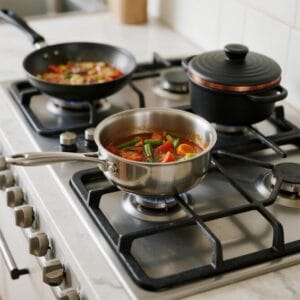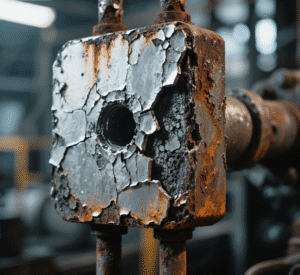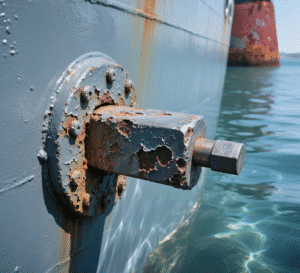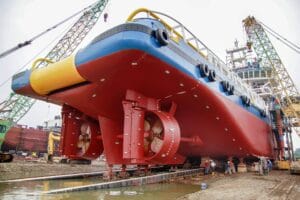Tired of pots that cook unevenly or look dull on the table? Need something durable for cooking that’s also stylish enough to serve from directly? A triply cook and serve pot solves this.
It’s a cooking pot made with three bonded metal layers (stainless steel inside, aluminum core, stainless steel outside) designed for efficient cooking and attractive enough for table presentation.
Before these multi-layer materials became common, I always thought standard stainless steel was better than the usual aluminum non-stick pans. Why? Less worry about chemical coatings, much stronger, and they don’t bend out of shape easily. But even with stainless steel, quality varies – basic grades like 201 or 410 aren’t the best, while 304 is what you really want for the inside surface that touches your food.
Then, about a decade or so ago, triply construction became widespread. It’s a clever way to combine the best parts of different metals:
- Inner Layer: Food-grade 304 stainless steel – safe, doesn’t rust easily, won’t react with food .
- Core Layer: Aluminum – heats up fast and spreads the heat very evenly, preventing hot spots .
- Outer Layer: Usually 430 stainless steel – durable, looks good, and is magnetic, so it works on induction cooktops .
This structure fixes problems like food burning in one spot while another part is undercooked, or pans not working on newer induction stoves. A "cook and serve" pot specifically uses this excellent triply construction but is also designed with aesthetics in mind – think nice handles, polished finishes, and shapes suitable for bringing right to the dining table. I’ve personally used various triply items for over 12 years and they really deliver on performance, durability, and ease of care. It’s why I confidently work in selling both the raw material (triply circles) and the finished cookware. Let’s explore some common questions about this type of cookware.
What are the disadvantages of Triply cookware?
Heard triply is great but worried about hidden downsides? Concerned it might be too expensive or heavy for everyday use? Understanding the trade-offs helps you decide wisely.
The main disadvantages are higher cost compared to basic cookware, increased weight due to the multiple layers, and the fact that it isn’t inherently non-stick like coated pans .
While I genuinely believe in the quality and performance of triply cookware, it’s important to be realistic about its characteristics. No product is perfect for everyone. Based on my experience and customer feedback, here are the points usually considered drawbacks:
Understanding the Trade-offs
- Higher Cost: Quality triply cookware costs more than standard single-layer stainless steel or most basic aluminum non-stick pans. This is because the raw materials (good quality steel and aluminum) are more expensive, and the manufacturing process to perfectly bond these layers together (cladding) is more complex and requires precision engineering. When I talk to my B2B clients, like factory owners or purchasers, we discuss how this higher initial cost translates to better long-term value for the end customer due to durability and cooking performance, but the upfront investment is definitely greater.
- Increased Weight: Combining three layers of metal naturally makes the cookware heavier than pans made from a single layer of aluminum or thinner stainless steel . While this weight contributes to the sturdy feel and helps with even heat distribution, it can make handling the pots and pans more difficult, especially when full. For some users, particularly those who prefer very lightweight kitchen tools, this can be a significant factor.
- Not Non-Stick: This is a frequent point of confusion. Triply cookware has a pure stainless steel cooking surface. Unlike pans with a PTFE (like Teflon) or ceramic coating, it doesn’t have inherent non-stick properties. Food can stick if you don’t use the right cooking technique – typically preheating the pan properly, using enough cooking fat (oil or butter), and allowing food (especially proteins) to sear and release naturally before trying to move it. There’s often a learning curve for people used to non-stick surfaces.
- Potential for Staining/Discoloration: While durable, stainless steel can sometimes show water spots, fingerprints, or develop a bluish or brownish "heat tint" over time, especially if overheated. This doesn’t affect performance or safety but can bother those who want their cookware to look pristine forever. Proper cleaning (avoiding harsh abrasives) and occasional use of a specialized stainless steel cleaner can manage this .
Knowing these points allows potential buyers, whether end-users or businesses sourcing products, to weigh the performance benefits against these practical considerations.
How to tell if a pan is triply?
Shopping for new cookware and confused by the labels? Want to ensure you’re actually getting multi-layer construction? Learning a few simple checks can help you identify triply pans.
Look at the edge for visible layers, feel the weight (often heavier), check markings like "Tri-Ply" or "Clad," note the higher price, and test the outer base with a magnet for induction compatibility.
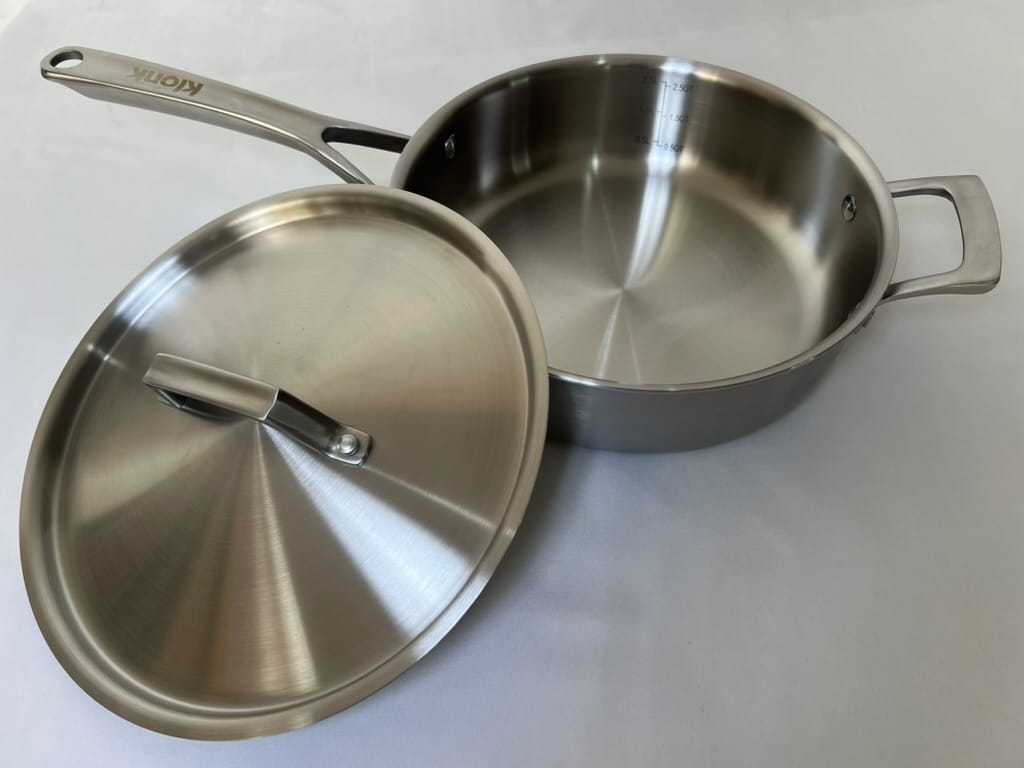 "Identifying Tri-Ply Cookware Layers")
"Identifying Tri-Ply Cookware Layers")
Identifying genuine triply cookware, especially when buying in person or assessing samples, involves looking for a few key indicators. While manufacturers often label it clearly, sometimes you need to investigate a bit more. Here’s what I look for:
Key Identification Methods
- Examine the Rim/Edge: This is often the most direct way. Look closely at the top edge of the pot or pan. On well-made triply cookware, you can often see the distinct sandwich of the three layers – two thinner outer layers of stainless steel and a thicker core layer (usually aluminum, which looks duller) in between [^3]. Some manufacturers polish the edge smoothly, making it harder to see, but often the lines are visible.
- Feel the Weight and Thickness: Triply cookware generally feels more substantial and heavier than basic single-layer stainless steel or aluminum pans of the same size due to the multiple layers . It often has a balanced, solid feel. Compare it to a known non-triply pan if possible.
- Check Manufacturer Markings: Look on the bottom of the pan or sometimes on the handle. Reputable brands will often stamp or etch terms like "Tri-Ply," "3-Ply," "Clad," "Multi-Clad," or indicate the specific layers (e.g., "Stainless-Aluminum-Stainless"). The absence of such markings doesn’t always mean it’s not triply, but their presence is a strong indicator.
- Consider the Price Point: Genuine triply construction is more expensive to produce . If a pan looks like stainless steel but is priced very cheaply, it’s more likely to be single-layer stainless steel or have just a disc bottom (sandwich base) rather than full triply cladding. Price isn’t definitive, but it’s a useful clue.
- Magnetic Test (for Induction Compatibility): Triply cookware designed for induction will have a magnetic outer layer (typically 430 stainless steel) . Take a small magnet and see if it sticks firmly to the outside bottom of the pan. If it does, it’s induction compatible. While this doesn’t guarantee it’s triply (some disc-bottom pans are also magnetic), most fully clad triply pans are made to be induction-ready. Note: The inside (304 stainless steel) is usually not magnetic.
- Performance (If Testing is Possible): Triply cookware heats noticeably more evenly than cheap single-layer pans . If you can test it, observe how quickly and uniformly water heats or how evenly oil shimmers across the surface.
By combining these checks, you can be reasonably confident in identifying whether a piece of cookware uses triply construction.Which is better, cast iron or triply stainless steel?
Trying to choose between the old-school reliability of cast iron and modern triply? Both are great, but excel in different ways. Comparing them helps find the best fit for your cooking style.
Neither is definitively "better" overall; they suit different needs. Triply heats faster and more evenly, is lighter, and requires less maintenance. Cast iron retains heat longer, is great for searing, but is heavy and needs seasoning.
 "Cast Iron vs Tri-Ply Stainless Steel Cookware")
"Cast Iron vs Tri-Ply Stainless Steel Cookware")
This is a common debate, as both cast iron and triply stainless steel are highly regarded, durable cookware options, but they offer very different user experiences. As someone who supplies materials for cookware, I see the demand for both, targeted at different cooking preferences.
Comparing Key Characteristics
Let’s break down the comparison:
| Feature | Cast Iron | Triply Stainless Steel |
|---|---|---|
| Heating Speed | Slow to heat up | Heats up relatively quickly |
| Heat Distribution | Can have hot spots until fully heated | Very even heating due to aluminum core [^1] |
| Heat Retention | Excellent; stays hot for a long time | Good, better than thin pans, but less than CI |
| Maintenance | Requires seasoning; prone to rust if wet | Easy wash; no seasoning needed |
| Weight | Very heavy | Moderate weight, lighter than cast iron |
| Reactivity | Can react with acidic foods (esp. unseasoned) | Non-reactive stainless steel surface |
| Non-Stick | Can become very non-stick when seasoned | Not naturally non-stick; requires technique/fat |
| Versatility (Oven) | Excellent, usually oven-proof to high temps | Often oven-proof (check handle limits) |
| Versatility (Stovetop) | Works on most (incl. induction if flat) | Works on all, including induction |
| Durability | Extremely durable, can last generations | Very durable, resistant to warping/scratching |
| Cost | Generally inexpensive | More expensive than basic cast iron |
Choose Cast Iron if: You prioritize exceptional heat retention for searing, deep-frying, or baking; you enjoy the process of seasoning and care; you don’t mind the heavy weight; you want cookware that can potentially last centuries.
Choose Triply Stainless Steel if: You value fast and even heating for precise temperature control; you prefer easier cleanup and lower maintenance; you want a lighter weight pan; you cook acidic foods often; you need guaranteed induction compatibility and a modern look .
For many everyday tasks like boiling, sautéing, making sauces, or quick meals, triply often offers more convenience and control . For specific high-heat searing or tasks where steady, prolonged heat is key, cast iron excels. Many kitchens benefit from having both!
Which is better triply or sandwich bottom cookware?
Seen pans labeled "sandwich bottom" or "disc base"? Wondering how they compare to fully clad triply? Understanding the construction difference reveals why triply often performs better.
Triply (fully clad) is generally better as heat spreads up the sides too. Sandwich bottom only heats evenly across the base, which can lead to scorching up the sides, though it’s often cheaper.
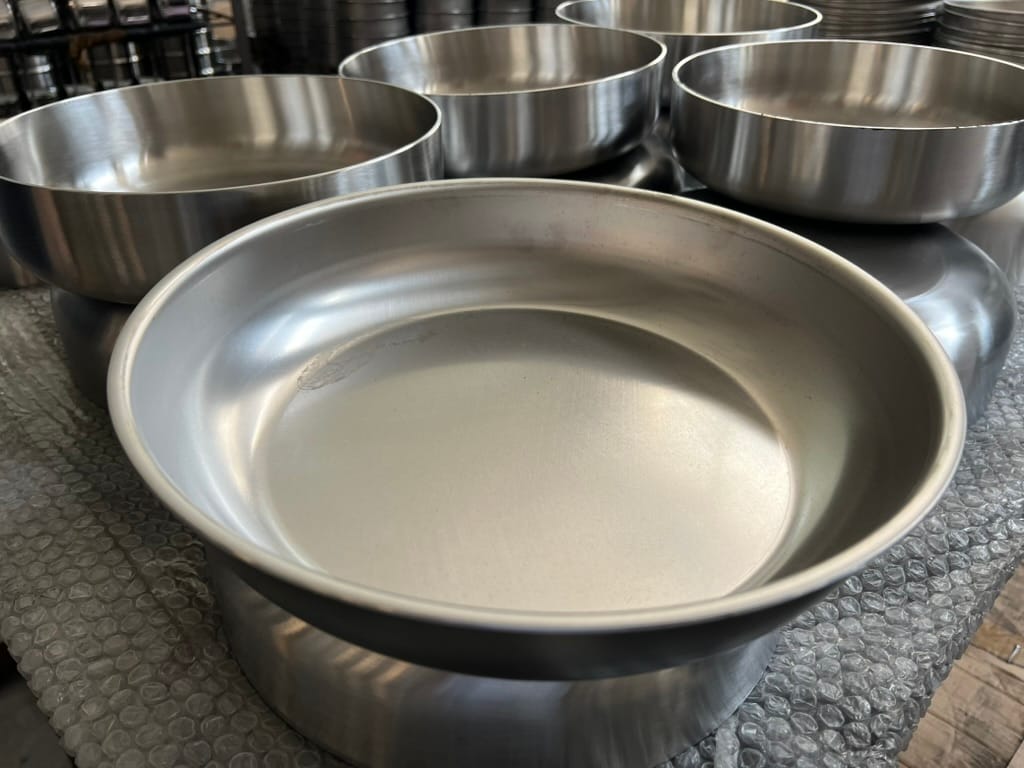 "Heat Distribution: Triply vs Sandwich Bottom")
"Heat Distribution: Triply vs Sandwich Bottom")
This question gets to the heart of different multi-layer cookware constructions. While both aim to improve on basic single-layer pans, they do it differently, impacting performance.
Construction and Performance Differences
- What is Sandwich Bottom? Also known as an encapsulated base or disc bottom, this type of cookware has a standard single-layer stainless steel body (sides and interior base). A thick disc, usually containing aluminum (and sometimes a steel plate for induction), is then bonded only to the exterior bottom of the pot. The sides remain single-layer steel.
- What is Triply (Fully Clad)? As we’ve discussed, triply cookware consists of three layers (Stainless-Aluminum-Stainless) that are bonded together to form the entire body of the cookware – base and sides. Think of it as a single sheet of multi-layer metal formed into a pot shape.
- Heat Distribution: This is the critical difference.
- Sandwich Bottom: The aluminum disc provides good, even heat distribution across the flat base. However, the single-layer steel sides don’t benefit from the aluminum’s conductivity. They heat up much slower and mainly where they directly contact the food being heated by the base, or from the flame/element licking up the sides. This can lead to food sticking or scorching on the lower parts of the sides where the heat transition is abrupt.
- Triply: Because the aluminum core extends up the sides, heat travels quickly and evenly not just across the base but also up the walls of the pot [^1]. This creates a more uniform cooking environment, reducing hot spots and promoting even simmering or boiling without scorching near the base/side junction. This is particularly noticeable when making sauces or reducing liquids.
- Durability: While both can be durable, some lower-quality sandwich bottoms have occasionally faced issues with the disc delaminating (separating slightly) from the main pot body over time, though this is less common with good manufacturing. Fully clad triply cookware is inherently a single, integrated piece, eliminating this specific risk.
- Cost and Weight: Sandwich bottom construction is generally less expensive and often results in slightly lighter cookware than fully clad triply, as less aluminum and a simpler manufacturing process are involved.
Conclusion: For overall cooking performance, especially tasks involving liquids or requiring even heat up the sides, fully clad triply cookware is generally superior to sandwich bottom cookware . Sandwich bottom is a good improvement over basic single-layer pans and offers better value, but triply provides more consistent and responsive heating throughout the entire vessel.
Conclusion
Triply stainless steel cook and serve pots offer excellent even heating, durability, and table-ready style. While heavier and pricier, they generally outperform cast iron and sandwich bottom options for versatility and ease.

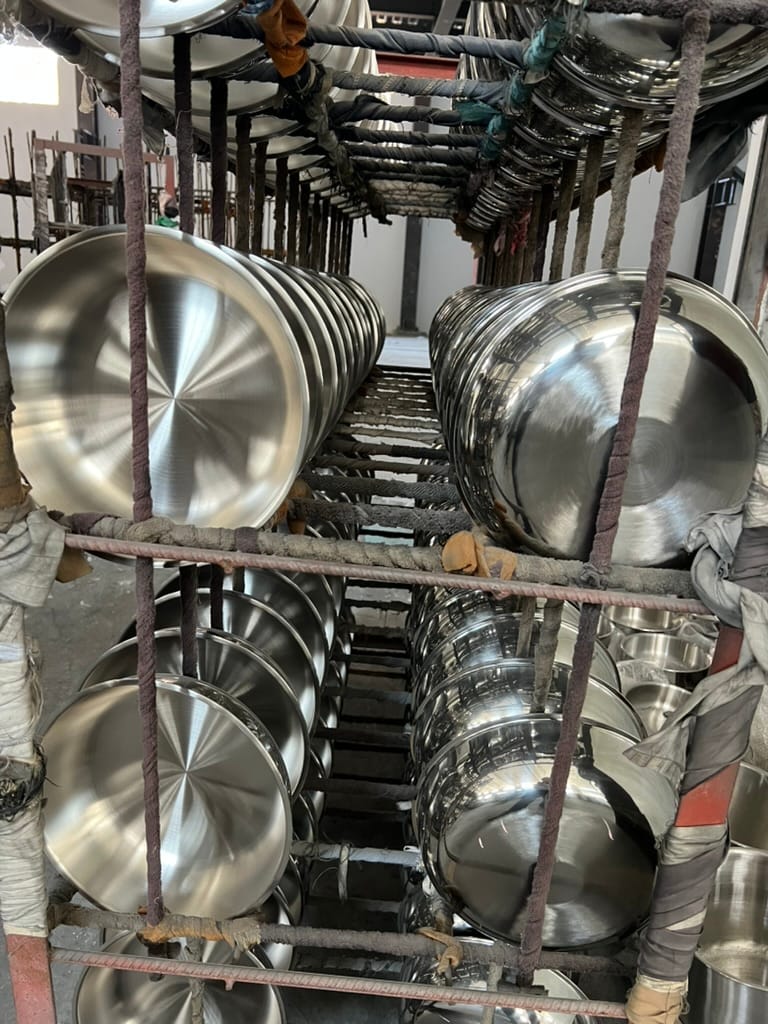
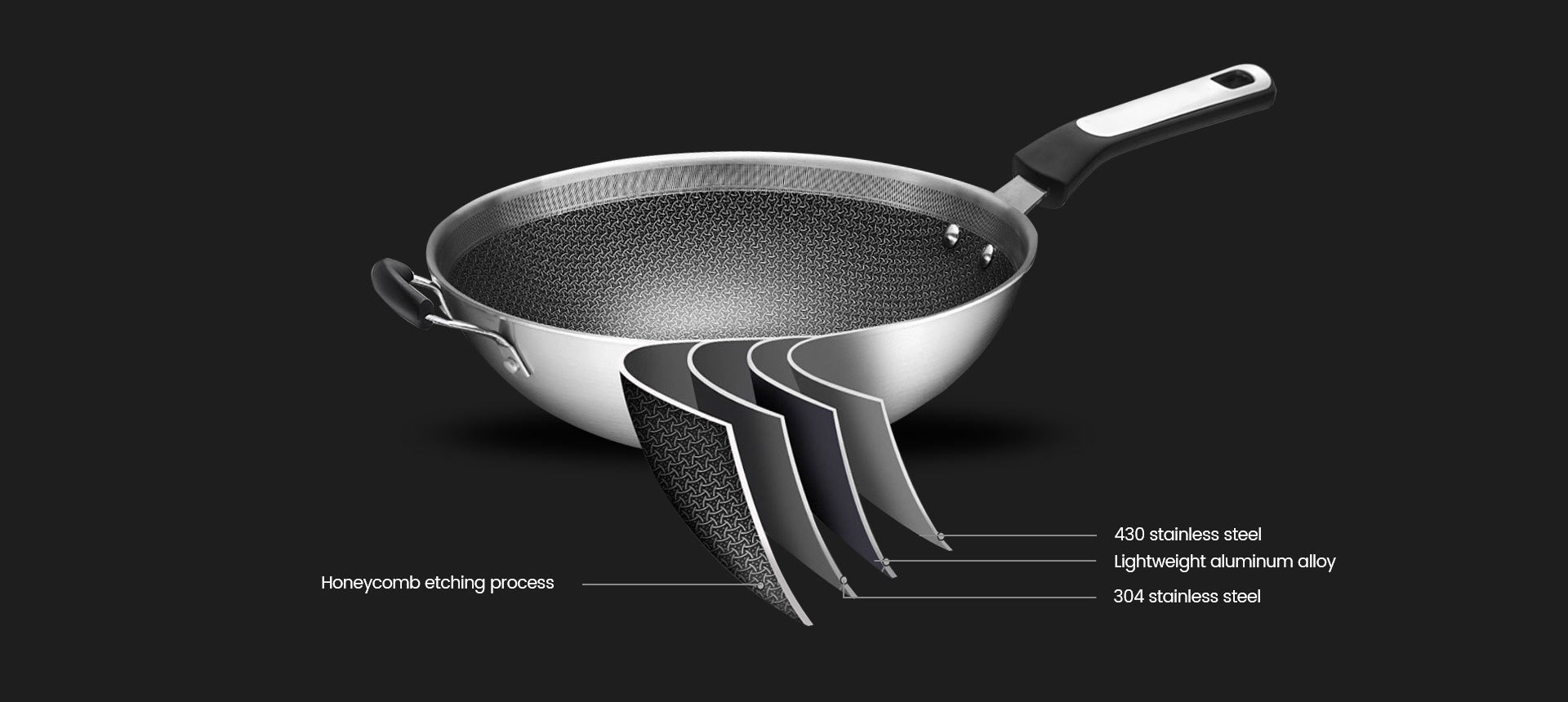 "Cast Iron vs Tri-Ply Stainless Steel Cookware")
"Cast Iron vs Tri-Ply Stainless Steel Cookware")
